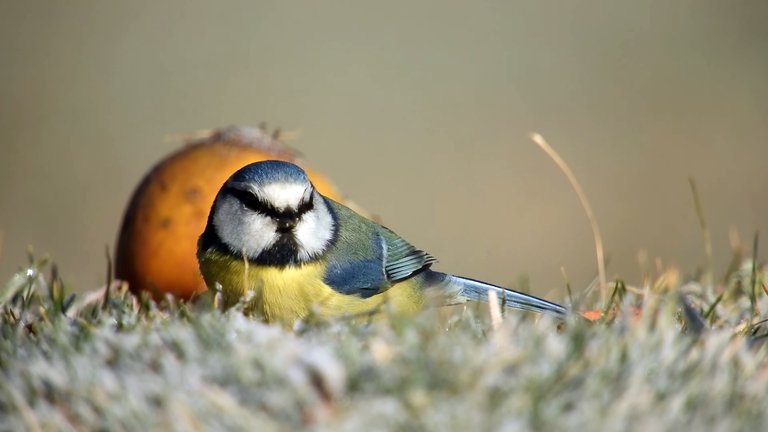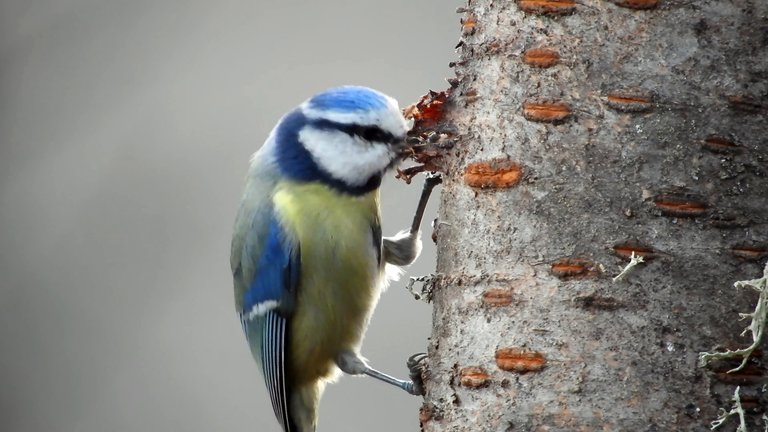
These are my favorites in the winter. I have a place in the park where I try to feed them with delicacies. From what I have observed, sunflower or walnuts are their favorite.
To moje ulubienice w okresie zimowym. Mam w parku swoje miejsce, gdzie staram się je dokarmiać smakołykami. Z tego co zaobserwowałem to najbardziej lubią słonecznik lub włoskie orzechy.

When I forget to bring food, they come over to me, sit on the bench, and then nervously tread on it looking for a sunflower.
Gdy zdarzy mi się zapomnieć przynieść pożywienie, podlatują do mnie siadają na ławce, po czym nerwowo po niej stąpają szukając słonecznika.


Eventually they look at me like they blame me - how can I come to the park and bring them nothing to eat. I am waiting for a moment for them to eat out of my hand, maybe it will come this winter.
W końcu spoglądają na mnie, jakby miały do mnie pretensje - jak mogę przyjść do parku i nie przynieść im nic do jedzenia. Czekam na moment, aż będą jadły mi z ręki, może nastąpi jeszcze tej zimy.


Tit's favorite food
Ulubiony pokarm sikorek


They eat mainly insects that live on tree branches and leaves. They will not despise the seeds of oil-rich plants and a visit to the feeder, where they will eat whatever they want.
Zjadają głównie owady żyjące na gałązkach i liściach drzew. Nie pogardzą nasionami roślin bogatych w olej oraz wizytą w karmniku, gdzie zjedzą co popadnie.


Coloring of birds
Kolorystyka ptaków


The female and male of this species have the same coloration. Only young specimens are more delicately colored. They have yellowish cheeks and the top of the body is green-brown.
Samica i samiec tego gatunku mają identyczne ubarwienie. Jedynie młode osobniki są delikatniej ubarwione. Mają żółtawe policzki a wierzch ciała jest zielonobrązowy.


An adult male or female has characteristic white cheeks with a black stripe extending from the beak through the eye. A black stripe also runs across the neck, chest, and abdomen.
Dorosły samiec czy samica maja charakterystyczne białe policzki z czarnym paskiem ciągnącym się od dziobu poprzez oko. Czarny pasek przebiega również przez szyję, pierś i brzuch.


The head has a beautiful blue or even turquoise color, which distinguishes it from the more popular Titmouse tit, whose head is dark blue - almost black. The entire belly is yellow. The wings range from gray to dark blue to black
Głowa ma piękny błękitny lub wręcz turkusowy kolor, co odróżnia ją od bardziej popularnej sikorki Bogatki, której główka jest ciemnogranatowa - niemalże czarna. Cały brzuszek jest żółty. Skrzydełka przechodzą od koloru szarego poprzez ciemnoniebieski do czarnego

Titmouse is not too big, its body weight does not exceed about 10 g, the wingspan is about 20 cm, and the body length is 11-12 cm.
Sikorki nie są zbyt wielkie, ich masa ciała nie przekracza ok.10 g, rozpiętość skrzydeł ma około 20cm, a długość ciała 11-12 cm.
Acrobatic skills
Zdolności akrobatyczne



They are incredibly agile and fast birds. They make a decision in the air in a fraction of a second and can even hang like a hummingbird in one place.
Są to ptaszki niesamowicie zwrotne i szybkie. Podejmują decyzję w powietrzu w ułamku sekundy i potrafią wręcz zawisnąć jak koliber w jednym miejscu.


In addition, they can very efficiently hang on a branch or clip into a tree trunk, taking on amazing poses. They effectively help themselves with their feet with long claws in processing and splitting food.
Oprócz tego, bardzo sprawnie potrafią zawisnąć na gałęzi lub wpiąć się w pień drzewa przybierając przy tym niesamowite pozy. Skutecznie pomagają sobie stopkami opatrzonymi w długie pazurki w obrabianiu i rozłupywaniu pożywienia.


Where they like to live
Gdzie lubią mieszkać



Blue titmouse live mainly in deciduous and mixed forests with a predominance of deciduous trees. They like human habitats with buildings, they like fields with access to bushes and riverside areas. They are rarely found in coniferous forests.
Sikorki modre zamieszkują głównie lasy liściaste i mieszane z przewagą drzew liściastych. Lubią siedliska ludzkie z zabudową, lubią pola z dostępem do krzaków i okolice nadrzeczne. Rzadko można je spotkać w lasach iglastych.
Nest and offspring
Gniazdo i potomstwo


The bird nests mainly in tree hollows, but it also does not disdain nesting boxes. The nest is made of moss, dry grass, bird feathers. The first brood occurs most often in May, less frequently in June. Few pairs have the second brood in June. Female tit lays 7 to 12 eggs and incubates them by itself for about 2 weeks. After about 18 days, the young leave the nest.
Sikorka gnieździ się głównie w dziuplach, ale nie pogardzi również skrzynkami lęgowymi. Gniazdo powstaje z mchu, suchej trawy, piór ptaków. Do pierwszego lęgu dochodzi najczęściej w maju rzadziej w czerwcu. Nieliczne pary wyprowadzają drugi lęg w czerwcu. Samica sikorki składa od 7 do 12 jaj i wysiaduje je sama przez około 2 tygodnie. Po mniej więcej 18 dniach młode opuszczają gniazdo.

Enjoy 😉

Wonderful shots and information
We appreciate your work and your post was manually curated by @nelinoeva from the DNA team!
Reach us on Discord to learn more about the project!
Wonderful photos of a beautiful bird! Thanks to share them ❤️
😉
so many nice shots and very informative text. thanks for sharing